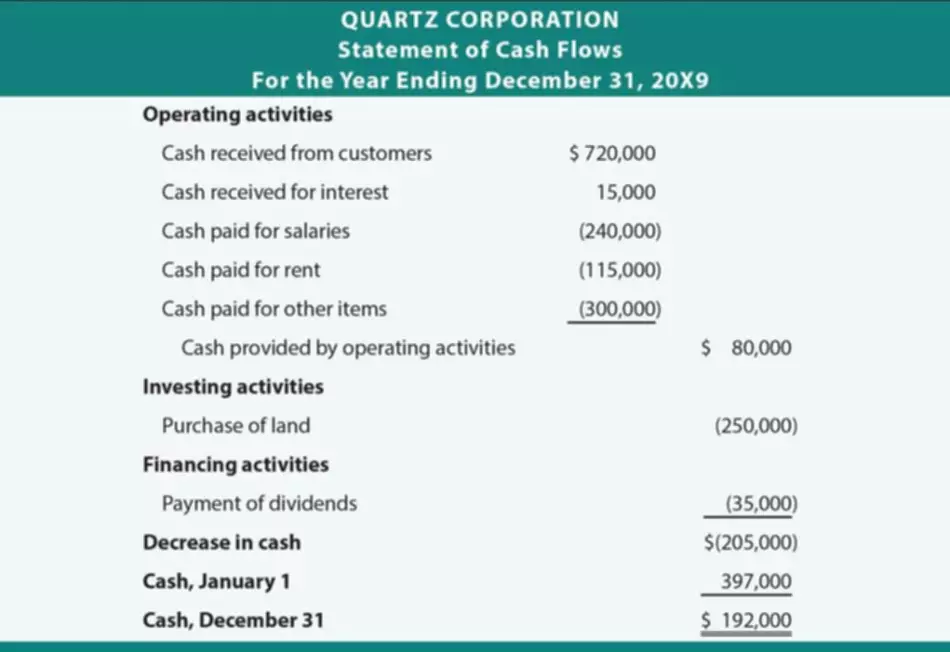Contents:


We also refer to it as the grant accounting of owner’s equity, and accountants prepare them according to GAAP principles. The third line should present the schedule’s preparation date as “For the Year Ended XXXXX.” For the word “year,” any accounting time period can be entered, such as month, quarter, or year. Remember to do your due diligence and understand the risks involved when investing. Ensure your investment aligns with your company’s long-term goals and core values. That’s why you must carefully consider how best to use your company’s retained earnings.
Differences Between Non-Profit and For-Profit Financial Statements – ReadWrite
Differences Between Non-Profit and For-Profit Financial Statements.
Posted: Mon, 10 Apr 2023 18:01:38 GMT [source]
For example, let us say the Company ABC Inc. paid a dividend of $ to the shareholders. Therefore, to record net income in the statement, the company should prepare the income statement first and then the retained earnings statement. The first entry on the statement is the previous year’s carried-over balance. This entry can be taken from the previous year’s balance sheet or the ending balance of the previous year’s retained earnings.
For instance, a company may declare a stock dividend of 10%, as per which the company would have to issue 0.10 shares for each share held by the existing stockholders. Thus, if you as a shareholder of the company owned 200 shares, you would own 20 additional shares, or a total of 220 (200 + (0.10 x 200)) shares once the company declares the stock dividend. However, management on the other hand prefers to reinvest surplus earnings in the business. This is because reinvestment of surplus earnings in the profitable investment avenues means increased future earnings for the company, eventually leading to increased future dividends. Retained earnings refer to the residual net income or profit after tax which is not distributed as dividends to the shareholders but is reinvested in the business. Typically, the net profit earned by your business entity is either distributed as dividends to shareholders or is retained in the business for its growth and expansion.
Retained earnings represent accumulated profits over time and can be used for things such as reinvesting in the business or paying off debts. Understanding what retained earnings represent is crucial for investors and stakeholders looking at a company’s financial statements. It provides insights into how well-run and profitable a business is over time and its capacity for growth in future periods. When Business Consulting Company will prepare its balance sheet, it will report this ending balance of $35,000 as part of stockholders’ equity. You can see this presentation in the format section of the next page of this chapter – the balance sheet. This represents capital that the company has made in income during its history and chose to hold onto rather than paying out dividends.
Share repurchases
That’s pretty simple; keep in mind that any changes in the income statement will be reflected in the retained earnings. The statement also shows how the retained earnings accumulated on the balance sheet. One of the primary purposes of retaining earnings is to reinvest them into the business for expansion, research and development or other strategic initiatives.
Retained earnings can also indicate something about the maturity of a company—if the company has been in operation long enough, it may not need to hold on to these earnings. In this case, dividends can be paid out to stockholders, or extra cash might be put to use. Because the income statement “resets” each year, all revenue and expense activity is transferred out of nominal accounts and into real accounts on the balance sheet. Thus, stock dividends lead to the transfer of the amount from the retained earnings account to the common stock account. Say, if the company had a total of 100,000 outstanding shares prior to the stock dividend, it now has 110,000 (100,000 + 0.10×100,000) outstanding shares. So, if you as an investor had a 0.2% (200/100,000) stake in the company prior to the stock dividend, you still own a 0.2% stake (220/110,000).
Business Line of Credit: Compare the Best Options
Looking at the income statement columns, we see that all revenue and expense accounts are listed in either the debit or credit column. This is a reminder that the income statement itself does not organize information into debits and credits, but we do use this presentation on a 10-column worksheet. For example, IFRS-based financial statements are only required to report the current period of information and the information for the prior period. US GAAP has no requirement for reporting prior periods, but the SEC requires that companies present one prior period for the Balance Sheet and three prior periods for the Income Statement. Under both IFRS and US GAAP, companies can report more than the minimum requirements.
More mature companies generate more net income and give more to shareholders. Less mature companies need to retain more profit in shareholder’s equity for stability. Revenue on the income statement is often a focus for many stakeholders, but the impact of a company’s revenues affects the balance sheet. If the company makes cash sales, a company’s balance sheet reflects higher cash balances. Companies that invoice their sales for payment at a later date will report this revenue as accounts receivable.
At the end of every year, the company’s net income gets rolled into retained earnings. Therefore, a single number of retained earnings could contain decades of historical value accumulated over a much longer reporting period. Are reported on the balance sheet as well as the statement of retained earnings. The statement is most commonly used when issuing financial statements to entities outside of a business, such as investors and lenders. When financial statements are developed strictly for internal use, this statement is usually not included, on the grounds that it is not needed from an operational perspective. In fact, both management and the investors would want to retain earnings if they are aware that the company has profitable investment opportunities.
Next you will take all of the figures in the adjusted trial balance columns and carry them over to either the income statement columns or the balance sheet columns. Is an all-in-one spreadsheet showing the transition of account information from the trial balance through the financial statements. Accountants use the 10-column worksheet to help calculate end-of-period adjustments. Using a 10-column worksheet is an optional step companies may use in their accounting process.
As we will see, the statement reveals whether the company will reward us with dividends, share repurchases, or by retaining the earnings for future opportunities. Clear Lake Sporting Goods incurred utility expenses during the current period . In the month that followed, the utilities vendor sent an invoice for $1,500. It will reflect an expense of $1,500 on the income statement for the utilities expense. So is it safe to assume that because Clear Lake has an expense, it also used cash?
Both revenue and retained earnings are important in evaluating a company’s financial health, but they highlight different aspects of the financial picture. Revenue sits at the top of theincome statementand is often referred to as the top-line number when describing a company’s financial performance. Profits give a lot of room to the business owner or the company management to use the surplus money earned. This profit is often paid out to shareholders, but it can also be reinvested back into the company for growth purposes.
Share this post
This reveals how much of the company’s earnings have been distributed to shareholders. Another factor influencing retained earnings is the distribution of dividends to shareholders. When a company pays dividends, its retained earnings are reduced by the dividend payout amount. So, if a company pays out $1,000 in dividends, its retained earnings will decrease by that amount.
Next, notice that Wells Fargo has also paid out dividends to common and preferred stockholders. The flow from each statement to each statement is fascinating and helps illustrate how each statement is connected, and the impact each line item can have on the entire outlook of a company. Buffett includes an “Owners Manual” in his annual reports, which you can find here.
As stated earlier, companies may pay out either cash or stock dividends. Cash dividends result in an outflow of cash and are paid on a per-share basis. The retained earnings formula calculates the balance in the retained earnings account at the end of an accounting period. In the long run, such initiatives may lead to better returns for the company shareholders instead of those gained from dividend payouts.
Retained earnings vs. cash flow
Retained earnings appear on the balance sheet under the shareholders’ equity section. Properly preparing a statement of retained earnings is essential for ensuring the accuracy of financial reporting and demonstrating a company’s commitment to transparency and accountability. The accountant then subtracts the company’s dividends of $50,000 from the net income to get the change in retained earnings. The difference in retained earnings is $50,000, meaning the company’s retained earnings increased by $50,000 from the previous fiscal year. Newer companies generally don’t pay dividends to the shareholders as it needs the money for the growth of the company. Already established businesses usually do pay dividends as it will have enough profit for growth projects as well as the shareholders.

Finally, provide the year for which such a statement is being prepared in the third line . The retained earnings amount can also be used for share repurchase to improve the value of your company stock. Movements in a company’s equity balances are shown in a company’s statement of changes in equity, which is a supplementary statement that publicly traded companies are required to show.
Preparing a Statement of Retained Earnings
You may notice that dividends are included in our 10-column worksheet balance sheet columns even though this account is not included on a balance sheet. There is actually a very good reason we put dividends in the balance sheet columns. The statement of retained earnings is also called a statement of shareholders’ equity or a statement of owner’s equity. At each reporting date, companies add net income to the retained earnings, net of any deductions. Dividends, which are a distribution of a company’s equity to the shareholders, are deducted from net income because the dividend reduces the amount of equity left in the company. Retained earningsare a portion of a company’s profit that is held or retained from net income at the end of a reporting period and saved for future use as shareholder’s equity.
Annual General Meeting of Starrag Group Holding AG : All motions of the Board of Directors approved – Dividend of CHF 2.00 per registered share – Marketscreener.com
Annual General Meeting of Starrag Group Holding AG : All motions of the Board of Directors approved – Dividend of CHF 2.00 per registered share.
Posted: Fri, 21 Apr 2023 19:40:03 GMT [source]
When it comes to investors, they are interested in earning maximum returns on their investments. Where they know that management has profitable investment opportunities and have faith in the management’s capabilities, they would want management to retain surplus profits for higher returns. You can either distribute surplus income as dividends or reinvest the same as retained earnings.
What Is Retained Earnings?
Though gross revenue is helpful in accounting for, it may be misleading as it does not fully encapsulate the activity regarding sale activity. For example, a company may post record-level sales; however, a major recall that resulted in 10% of all sales being returned will have material consequences on net revenue. Gross sales are calculated by adding all sales receipts before discounts, returns, and allowances. For smaller companies, this may be as easy as calculating the number of products sold by the sales price.
In contrast, a growing Company is expected to retain the income and invest in future business, thus expecting an increase in the share price. As stated earlier, there is no change in the shareholder’s when stock dividends are paid out. However, you need to transfer the amount from the retained earnings part of the balance sheet to the paid-in capital.
- Many or all of the products featured here are from our partners who compensate us.
- Retained earnings are the portion of a company’s net income that is not paid out as dividends.
- Retained earnings is the residual value of a company after its expenses have been paid and dividends issued to shareholders.
- This net income figure is used to prepare the statement of retained earnings.
Retained earnings can be used for a variety of purposes and are derived from a company’s net income. Any time a company has net income, the retained earnings account will increase, while a net loss will decrease the amount of retained earnings. A stock dividend is a payment to shareholders that is made in additional shares rather than in cash. The retained earnings are calculated by adding net income to the previous term’s retained earnings and then subtracting any net dividend paid to the shareholders. Management and shareholders may want the company to retain the earnings for several different reasons.

Looking at the statement of retained earnings is a quick way to investigate the capital allocation of any company. In Buffett’s case, it appears he is keeping some dry powder in case he comes across a fantastic investment. Retained earnings are the portion of the profits not distributed to shareholders. Instead, companies hold back those earnings for investments in working capital or fixed assets.







